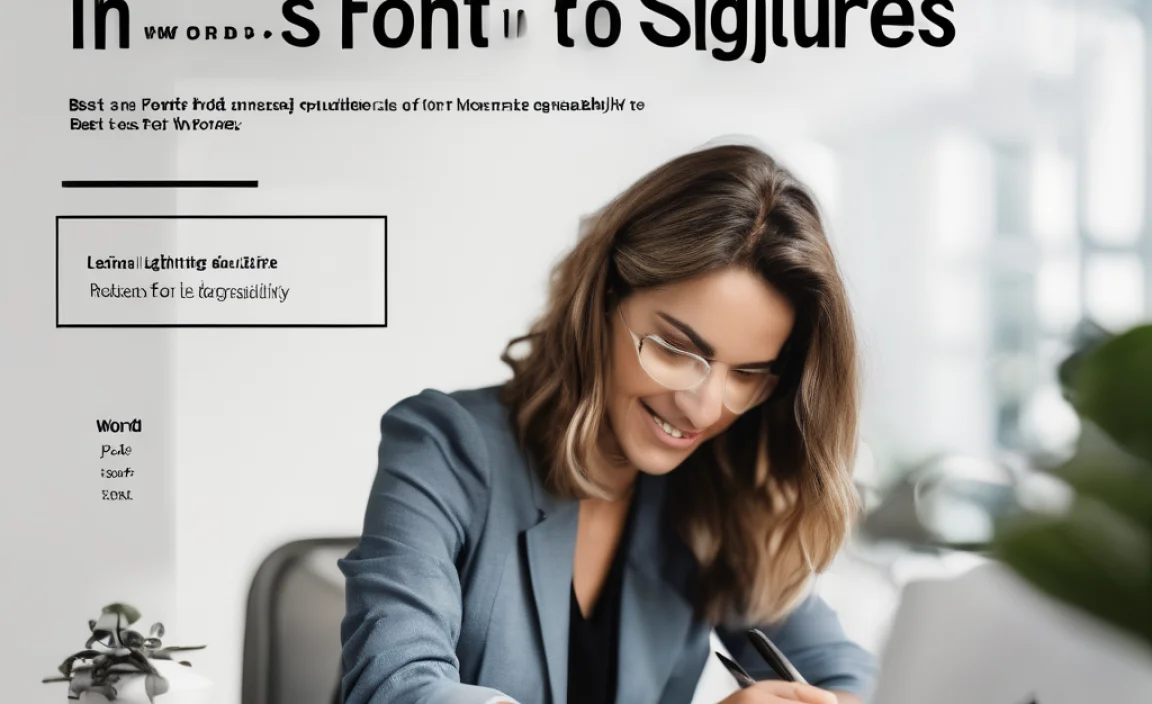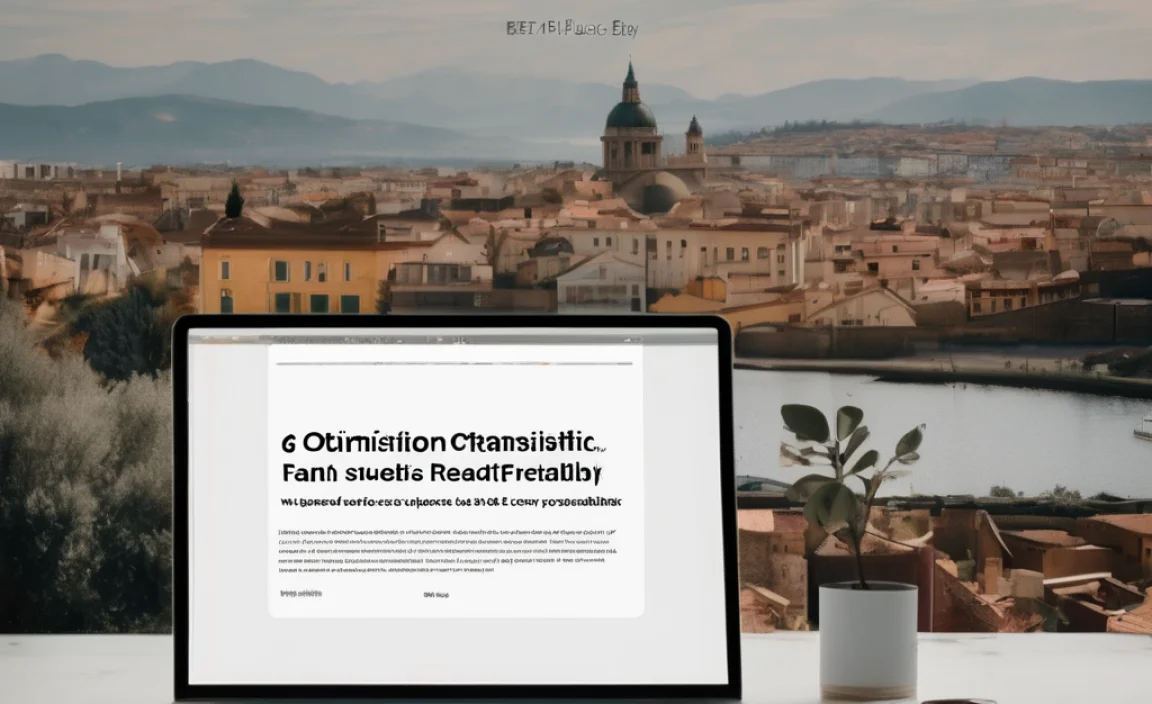The “Old Book Font” isn’t a single typeface, but a style evoking vintage charm and timeless readability often found in classic literature. Embrace its power to add sophistication, tradition, and a touch of nostalgia to your designs, making them feel more authored and intentionally crafted.
Have you ever opened an old book and felt a special connection to its pages? That feeling often comes from the font. These “old book fonts” have a way of making text feel warm, inviting, and full of stories. In today’s fast-paced digital world, artfully choosing fonts can seem tricky. But don’t worry! We’ll dive into the wonderful world of antique-style typography. We’ll explore why these fonts are so captivating and how you can use them to give your own projects that same treasured feel. Let’s unlock the magic together!
What Are “Old Book Fonts”?
When we talk about “old book fonts,” we’re not referring to one specific typeface. Instead, it’s a category of fonts that capture the aesthetic of historical printed materials. Think of the elegant, sometimes slightly imperfect letters you see in novels from the 18th, 19th, or early 20th centuries. These fonts often carry a sense of tradition, authority, and a gentle, scholarly charm. They are typically serif fonts, meaning they have small decorative strokes (serifs) at the ends of the main strokes of letters. These serifs can contribute to a flowing, readable experience that feels more deliberate and less rushed than modern sans-serif styles.
Why Do “Old Book Fonts” Captivate Us?
There’s a unique allure to fonts that remind us of classic literature and a bygone era. This fascination stems from several factors:
- Nostalgia and Comfort: These fonts tap into a sense of nostalgia for simpler times or for the joy of reading physical books. They can evoke feelings of warmth, tradition, and comfort, reminding us of cherished stories and quiet moments.
- Perceived Authority and Trust: For centuries, important documents, scholarly works, and beloved novels have been set in serif fonts. This long history lends these typefaces an air of authority, credibility, and timelessness. They feel established and trustworthy.
- Enhanced Readability: Many classic book fonts were designed with extended reading in mind. The serifs, counter-forms (the enclosed or partially enclosed areas of letters like ‘o’ or ‘p’), and letter spacing were optimized to guide the eye smoothly across the page, reducing fatigue for long reading sessions. You can learn more about the principles of typography and readability on the American Type Founders’ site, a historical resource for type enthusiasts.
- Aesthetic Sophistication: There’s an undeniable elegance to well-designed serif fonts. Their intricate details and balanced forms can add a touch of sophistication and refinement to any design, elevating its overall perceived quality.
- Storytelling and Evocation: These fonts inherently carry a narrative quality. They can instantly transport your audience, suggesting a story, a historical setting, or a particular mood – perfect for brands or projects aiming for a classic or artisanal feel.
Key Characteristics of “Old Book Fonts”
While diverse, fonts inspired by old books share common traits that give them their distinctive character. Understanding these features helps you identify and appreciate them:
- Serifs: This is the most defining characteristic. Serifs can be bracketed (curving gently into the stem) or unbracketed (a sharp, straight line). They aid readability by creating a visual baseline and guiding the eye.
- Contrast in Stroke Weight: Many of these fonts feature a noticeable difference between thick and thin strokes within a letterform. This adds a classic, calligraphic feel. For example, the vertical strokes of an ‘H’ might be much thicker than the horizontal crossbar.
- Subtle Imperfections: Some genuine antique fonts, or modern interpretations, might include slight irregularities that mimic the hand-set nature of old printing. This can include subtle variations in ink spread or letter alignment, ironically adding charm.
- Open Counterforms: The interior spaces within letters like ‘O’, ‘A’, ‘P’, and ‘R’ are often quite open. This contributes to clarity and legibility, especially at smaller sizes.
- Classic Letterforms: Shapes like the ‘g’ with a full loop, the ‘a’ with a distinct bowl and tail, and the ‘R’ with a flowing leg are common.
- Aged or Textured Appearance: In digital use, some “old book fonts” come with built-in textures or slight distressing to mimic printed paper and ink, enhancing the vintage effect.
Popular Types and Examples
When looking for that vintage book feel, you’ll often encounter specific categories and well-known examples. These are frequently categorized under “Old Style” or “Transitional” serif classifications, harkening back to specific periods of printing history.
Old Style Serifs (Pre-18th Century)
These fonts are characterized by their oblique stress (the thinnest part of the curve is not perfectly vertical) and moderate contrast between thick and thin strokes. They often have a more organic, hand-drawn quality.
- Garamond: A timeless classic, Garamond has elegant, flowing strokes and moderate contrast. Its readability has made it a favorite for books for centuries.
- Caslon: Known for its sturdy yet graceful appearance, Caslon is highly readable and possesses a warm, inviting tone. It was widely used in Britain and America.
- Bembo: Inspired by Renaissance typefaces, Bembo offers a refined, balanced aesthetic with a clear humanist influence.
Transitional Serifs (18th Century)
These fonts bridge the gap between Old Style and Modern serifs, featuring stronger contrast between thick and thin strokes and a more vertical stress.
- Times New Roman: Though ubiquitous today, its design was influenced by earlier transitional styles, aiming for a highly legible and efficient typeface for newspaper use.
- Baskerville: A prime example of transitional typography, Baskerville boasts sharper serifs, a higher contrast, and a more geometric construction than Old Style fonts.
Modern Serifs (Late 18th Century Onward)
While not typically what someone means by “old book font” for a warm, nostalgic feel, it’s good to know these: they have extreme contrast, vertical stress, and thin, unbracketed serifs. They have a more dramatic and less cozy feel.
Revival and Display Fonts
Many contemporary fonts are designed to specifically evoke historical printing. These can range from highly accurate revivals to more stylized interpretations for display purposes.
- The Antiqua/Groc/Garamond-like Revivals: Many foundries offer their versions, often slightly modernized for digital screens.
- Vintage Display Fonts: These are bolder, often more decorative, and meant for headlines or short bursts of text, designed to look like old advertisements or title pages.
How to Use “Old Book Fonts” in Your Designs
Incorporating these classic fonts can significantly impact your project’s mood and perception. Here’s how to use them effectively:
For Websites and Blogs
- Body Text: A well-chosen, readable serif font is excellent for the main content of your blog or website. It signals a focus on readability and offers a classic, literary feel. Pair it with a simpler sans-serif for headings to create contrast.
- Headlines and Titles: While body text is often best in subtler serifs, more decorative or distinctive revival fonts can work for main headlines, especially if your brand aims for a vintage, artisanal, or publishing-focused identity.
- About Pages and Branding: Use them to convey a sense of history, expertise, or a handcrafted approach.
- Example Pairing: Try pairing a font like Merriweather (a Google Font) for body text with a bolder sans-serif like Montserrat for headings. For a more pronounced “old book” feel, explore fonts like Lora or find classic revivals.
For Print Materials
- Books and Ebooks: This is their natural habitat! Choose fonts with excellent line spacing and letterforms designed for extended reading. Consider Garamond, Caslon, or Palatino for their proven track record.
- Brochures and Flyers: Use a classic serif for informational sections to lend credibility, and a more decorative serif or script for titles to add elegance.
- Invitations and Stationery: Perfect for weddings, formal events, or artisanal brand stationery to evoke a sense of timeless style and importance.
- Business Cards: A touch of a classic serif can make a business card feel more premium and established, especially for service-based businesses or creative professionals.
For Branding and Logos
- Subtle Elegance: A well-crafted serif logo can communicate sophistication, heritage, and quality. Think of luxury brands or established institutions.
- Informational Brands: If your brand is about knowledge, history, or craftsmanship, a font that echoes antique printing can be very fitting.
- Consider Pairing: A classic serif used in a logo can be beautifully complemented by a modern sans-serif in other branding applications for balance.
Choosing the Right “Old Book Font” for Your Project
Not all fonts that look like they belong in an old book are created equal. Here’s a guide to making the best choice:
| Factor | Considerations | Why it Matters |
|---|---|---|
| Intended Use | Body text, headlines, display, logo? | Some fonts are optimized for reading long passages, others for impact. |
| Readability | X-height, letter spacing, serif style (bracketed vs. unbracketed). | Crucial for body text to prevent eye strain and ensure comprehension. Modern digital screens can sometimes make very delicate serifs harder to read. |
| Tone and Personality | Formal, cozy, authoritative, whimsical? | Each font carries a unique feeling. A strong, angular serif feels different from a softly rounded one. |
| Contrast | Degree of difference between thick and thin strokes. | High contrast can feel more elegant but might be less readable in small sizes. Low contrast is generally more approachable. |
| Digital vs. Print | Screen rendering, file size, licensing. | Fonts designed for print might appear pixelated on screen. Web fonts need to be optimized for fast loading. Licensing is vital for commercial use. For resources on font licensing, consult the US Copyright Office for general guidance. |
| Availability and Licensing | Free (Google Fonts, Adobe Fonts) vs. paid. | Ensure you have the legal right to use the font for your project, especially for commercial purposes. |
Tools and Resources for Finding “Old Book Fonts”
Dive into the world of typography with these helpful platforms:
- Google Fonts: A fantastic free resource with a vast library. Search for terms like “serif,” “classic,” or browse by category. Look for fonts with names that hint at historical styles. Merriweather, Lora, and EB Garamond are excellent starts.
- Adobe Fonts (formerly Typekit): Included with Adobe Creative Cloud subscriptions, this offers a curated collection of high-quality fonts, many of which are historical revivals or classic designs.
- FontSpring, MyFonts, FontShop: These are premier marketplaces for purchasing professional fonts. You can find professional revivals of classic typefaces and expertly crafted modern interpretations with extensive licensing options.
- Specific Foundry Websites: Many foundries specialize in historical revivals. For instance, companies like Monotype, ITC, and Linotype have extensive archives.
- Typography Blogs and Communities: Websites and forums dedicated to typography often feature curated lists, reviews, and discussions about classic and vintage-inspired fonts.
Pairing “Old Book Fonts” with Other Typefaces
To create balance and visual interest, pairing your chosen “old book font” with other typefaces is essential. Here are some winning combinations:
- Serif Body Text + Sans-Serif Headlines: This is a classic and highly effective pairing. The serif provides warmth and readability for long text, while a clean sans-serif headline offers a modern contrast and strong visual hierarchy.
- Example: EB Garamond (body) with Open Sans (headlines).
- Example: Lora (body) with Lato (headlines).
- Sans-Serif Body Text + Serif Headlines: If you want a primarily modern feel but desire a touch of classic elegance for impact, use a clean sans-serif for readability and a more decorative or bold serif for headlines and key phrases.
- Example: Roboto (body) with Playfair Display (headlines).
- Example: Source Sans Pro (body) with Crimson Text (headlines).
- Serif + Script/Handwritten: For a romantic, artisanal, or vintage feel, pair a softer serif with a complementary script or handwritten font. Use the script sparingly for accents, names, or featured quotes.
- Example: Garamond Premier Pro (body) with a delicate script like Allura (accents).
- Serif + Serif (Carefully!): You can pair two serif fonts, but ensure they have distinct personalities or come from similar historical periods to avoid clashing. One might be for text, the other for display.
- Example: A sturdy Old Style like Goudy Old Style for body text with a more decorative Transitional or Slab Serif (for a distinct contrast) for strong headings.
When pairing, consider:
- Contrast: Ensure there’s enough difference in style, weight, or form between the fonts.
- Harmony: They should still feel like they belong together, perhaps sharing a common historical influence or a similar tone.
- Hierarchy: Use different fonts to clearly distinguish between headings, subheadings, and body text.
Potential Pitfalls and How to Avoid Them
Even with classic styles, there are a few common mistakes to watch out for:
- Overuse of Decorative Fonts: Display fonts meant for headlines shouldn’t be used for paragraphs. They quickly become unreadable. Always prioritize legibility for your main content.
- Choosing Fonts That Are Too “Fussy”: Some very old-style fonts have delicate details or intentional “imperfections” that look great in print but can appear messy or blurry on lower-resolution screens. Test them digitally!
- Ignoring Licensing: Using a font from an old scanned book for commercial purposes without proper licensing can lead to legal issues. Always use fonts obtained through legitimate sources with clear licensing agreements. Legal frameworks and licensing details can be found through resources like Pew Research Center’s discussions on digital text.
- Poor Pairing Combinations: Mismatched fonts can jar the reader. If in doubt, stick to the tried-and-true serif/sans-serif combinations described above.
- Bad Tracking and Leading: Even the best font will look poor if letters are too close together (bad tracking) or lines of text are too far apart or too close (bad leading). Learn basic typographic spacing principles.
FAQ About “Old Book Fonts”
<h3 id="what-is-










